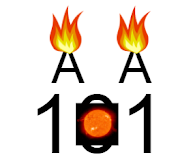Fast Llamas,
My first April Fools Day in a high school and no body tricked me! So different than middle school and I am liking it! But, it is already April and school is winding up... that's right, the months of April and May are super busy for schools. State testing, finals, finishing up grades, dances and yep, planning for next year. Since testing is coming up, when I ran across this visual it made me want to discuss remembering... in our case, memory.
In QL we use anchors to help us remember things. There are cognitive anchors, mnemonics, tags and pegs. All help you "hang" a memory on something physical or mental to help your brain recall it. Just like put your keys in the same place everyday to help you remember where they are, memories (learning) can be placed in a similar way.
Once, I wanted to learn the room numbers of several staff members, 10 in total. I struggle with my memory and wanted to increase my ability to recall room numbers quickly. So, I used memory strategy called "pegs". In a peg system, you learn (memorize) a peg that you attach what you want to remember. It's very visual and the weirder the association the better you will remember it. For example, one room was room 101. In my peg system, "1 is Sun". So, I imagined, the zero was a bright sun... the teacher I wanted to attach to the number "101" was Aaron. So, I attached flaming letter A's to the ones. I did the same for each of the numbers. this is what I was thinking and visualizing in my mind. It was animated...
To help me learn the information I did indeed follow the suggestions from the visual above.
1. Learn, Practice, Recall, Repeat
At the root of all learning are the communications between neurons in the brain. There are electrical impulses and can be measured with an electroencephalograph. These impulses are what we call brain waves. These brain waves become our memory. So, it makes sense that by actively practicing what we need to learn, the more active our brain becomes. In a study at Stanford, neuroscientists studied two groups of students. One group, actively studied throughout the day, making flash cards, visuals representations and annotated their reading. The other group did minimal work. When the neuroscientists studied their brain waves, specifically their Theta brain waves, the first group was significantly more active. What does this mean for teachers? Teach kids metacognitive skills where students are actively saying, drawing, writing and hearing what you want them to remember. Students need to be active in their learning and do what I love to say, "carrying the cognitive workload".
2. Practice Chunking
To learn my room numbers, I did my recall practice in chunks. I would not move on to the next room, until I had a solid grip on previous numbers. I also grouped the rooms into teams, made even easier that they were grouped in the same hallways. What does this mean for teachers? Chunk your students learning in bite sized attainable pieces. The brain needs time to diffuse information, too much information too quickly isn't processed well.
3. Use Metaphors and Stories
To help my learning, I thought about the teachers personalities and attached meaning to the little metaphors and anecdotes that helped me remember their rooms. This helped me match the numbers with them in a meaningful way. What does this mean for teachers? Teachers are the best storytellers! There is an arc to to storytelling, and curiosity is at the heart of it. Stories pique curiosity and this state of mind primes the brain for learning. Metaphors keep the brain an active participant in the learning.
4. Use Visuals and Spatial Memories
In my remembering practice, I pictured the room number, the peg and the teacher's name (the metaphor) actively in my recall. I would go through my recall practice, down the halls of my building. Once, I had the room numbers down, I would visualize the hallway and recall the room numbers. What does this mean for teachers? Use body mnemonics and areas of the room to attach to students learning. Have students complete retrieval practices using visuals.
5. Sleep
I actively use Theta scanning to help with recall. Theta scanning the active recall of learning right before you go to sleep. When you sleep the brain takes over, consolidating memory and preparing it for encoding into long term memory. During sleep is when the hippocampus goes to work. When you skimp on sleep, you skimp on the time for memory encoding. What does this mean for teachers? While we can't go to student's homes and encourage kids to go to sleep, we certainly can inform them of the power of sleep and how important it is to their brain health.
Neuroscience is to cool to me... but, more than that, it is important for teachers to understand how to make the most out of learning and for our students to understand that long-term learning is within their power.
*Side note to my project of learning room numbers. I did indeed learn them all and could recall them quickly. However, I three of them off by one number. Over the summer, the room numbers had been changed. Aaron's room was not 100, but, 102. What an absolute blow to me! Worse was my office (which I shared with other CCIS's) was a classroom, which was across the hall from Ms. Aaron. You probably know where this is going, yep, my room number was 101. Fellow co-workers got a big laugh out of that one! So, my advice... be sure you are doing all this work on the right information. Once I had learned it, I had to unlearn it. Ah, my brain!







No comments:
Post a Comment
Join in the conversation: